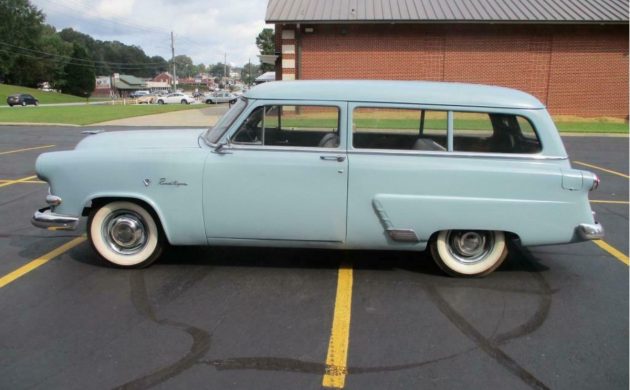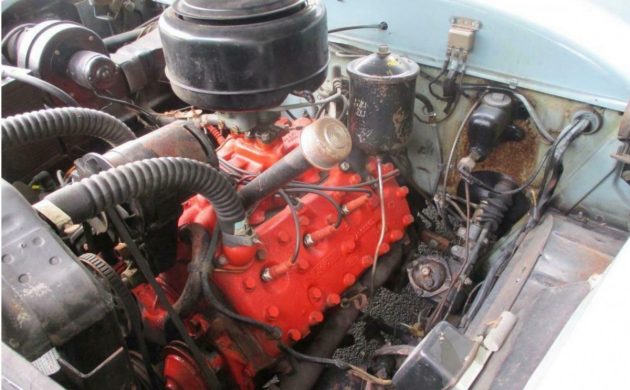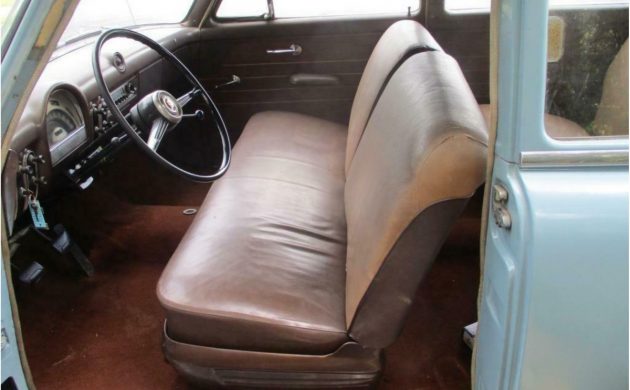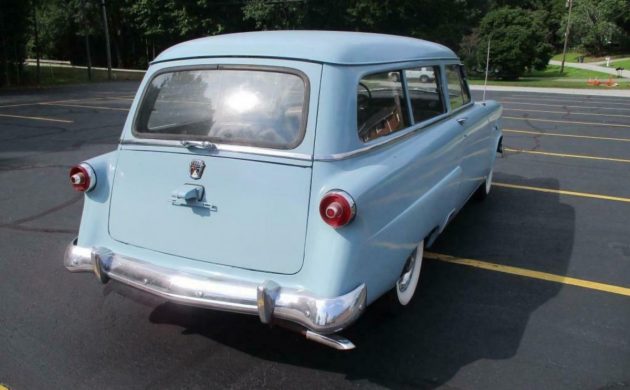Station wagons are a hot ticket in the classic market, and this trend shows no signs of changing. Many people buy a newer wagon as an alternative to a van or an SUV, but wagons like this 1953 Ford Ranch Wagon are more suited to people seeking a practical weekend motoring experience. It looks like a solid and clean survivor that features its original and healthy flathead V8 under the hood. Someone needs to give it a new home, so the owner has listed it for sale here on eBay. The Wagon is located in Bremen, Georgia, and while the owner has set the BIN at $17,500, he leaves the option to make an offer. I have to say a big thank you to Barn Finder Larry D for referring this tidy survivor to us.
The more that I look at this Ranch Wagon, the more that I find to like. I’m not sure if its Glacier Blue paint is original, but it holds an impressive shine for a vehicle with nearly seven decades under its belt. When we look at the steel hiding below that paint, the news remains just as positive. There might be the occasional mark or bruise, but there’s nothing that would be considered out of place in a survivor of this type. The other thing that this classic lacks are significant rust issues. I believe that there might be one older and quite solid patch in the floor, but that’s all that I can find. The rest of the floors and the frame show little beyond some surface corrosion, while the panels are spotless. The glass is in good order, with no marks or cracks. The owner admits that the bumpers would benefit from a trip to the platers, but the remaining trim has survived in remarkable condition.
There’s no question that Ford’s mighty 239ci flathead V8 was a great motor, which is what we find hiding under the hood of this Ranch Wagon. It should be producing 110hp, which finds its way to the rear wheels via a three-speed manual transmission. While the ¼-mile ET of 20.5 seconds might not sound particularly impressive, it’s worth noting that this is a six-seat family wagon that rolled off the line in 1953. When you place the figure in that perspective, it suddenly looks far better. The Ranch Wagon’s engine bay presents pretty well for a vehicle of this age, and it seems that appearances aren’t deceptive. The flathead runs well, and the transmission shifts smoothly. The owner admits that the whitewall tires are now rotted, and he advises that these should be changed before the buyer undertakes any serious journeys. Beyond that, this old Ford seems to need little.
The Ranch Wagon’s interior seems to continue the “tidy survivor” theme. The only functional fault that the owner identifies is an inoperative fuel gauge. He says the tank looks new, so it could be a fault with the sender unit or wiring. The electrical circuits for these are about as simple as they come, so tracing the problem should not be difficult. The seat upholstery is in excellent condition, with no wear or physical damage. The same is true of the headliner, while the carpet and door trims look excellent. The dash is crisp and clean, and even the factory radio operates as it should. If the buyer fixes the fuel gauge, this old girl is ready to go.
Finding an unmolested station wagon from the 1950s can be a battle because their owners saw many as prime candidates for a custom build. This 1953 Ford Ranch Wagon is like a breath of fresh air, and it wouldn’t take a lot of time or money to lift its already impressive presentation to the next level. This one looks to be an affordable option, and when you look at recent sales results and market trends, the BIN is extremely competitive. This is not the first time that the owner has listed it for sale, and he has wiped a cool $1,000 off the price compared to his earlier listings. That could be enough to motivate someone to hit the button, while others may hold out to see if the price drops further. Would you take that chance and risk being beaten to the punch by another buyer, or are you tempted to make a move now?








I wish people would put underbody shots in their ads. Ten pictures of bumpers and emblems suck. If this car is as nice as it looks it should have sold already. I’d do a in person inspection, just because it is a southern car doesn’t mean it has no rust issues.
Gary, go to the original ad. Plenty of under body pics.
Adam I’d like to know how you figure there is a floor patch when there is no underbody shots or pulled back carpet shots in the Ebay ad.
If you scroll down the eBay page there is a link to ‘Full size photos.’
I wouldn’t mind owning this old girl. I doubt if anyone ever raced one unless the teenage child borrowed it from a parent to cruise in. Maybe then.
Beautiful and very well kept. I’m sure the gas guage can be fixed with little effort. What makes this so attractive IS the original flathead V8! You don’t find that many left any more, and this one’s been taken care of. Wish I had the money. At car shows, MANY would say, “My mom drove one of these when I was a kid!!”
Not sure if the glacier blue paint is original? Seriously? With copious amounts of overspray one might suggest some reading glasses AND actually looking at the photos your commentary will accompany! The car is very nice and would be a fun driver. Price seems a little high but what isn’t today, right?
Nice original car just drive it. Nice to see a flathead engine in it.
I know nothing about restoring cars. So my question is, about how much should it cost to have two basic seat belts (not shoulder belts) installed for the front seat, parts and labor? Thanks.
Last I needed seat belts (about 10 yrs ago), lap belts were about $125 each and I’d figure about $25/belt for grade 8 mounting hardware. It took no more than an hour to install them.
I personally prefer the last year flathead over the first year y block (239). The latter had some teething problems.
One of my brothers ( now deceased) bought a 54 model in 55. He put over 300,000 miles on the beast. It was two tone green and had the ohv 239 with three on tree and over drive. He finally traded on a 64 Fairlane 4 door sedan.
God bless America
Finding an unmolested station wagon from the 1950s can be a battle not because of being someone making a custom build, but because they are over 60 years old and most wagons weren’t taken car of, they were used as family haulers, then used as trucks, and if the motors weren’t pulled to get put in a 2 door car , they ended up in demo derbies or were crushed out for their value in weight